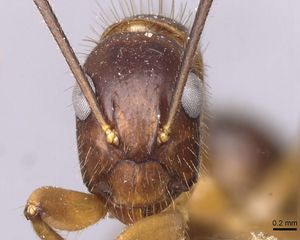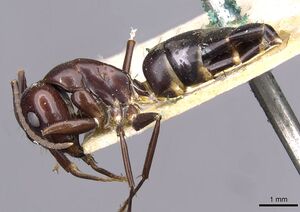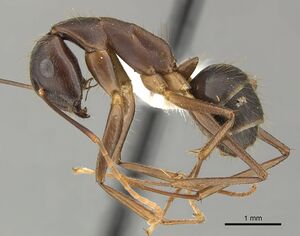AntWiki: The Ants --- Online
Identification
Distribution
Latitudinal Distribution Pattern
Latitudinal Range: 25.5° to -22.63784674°.
Neotropical Region: Brazil, Ecuador, French Guiana (type locality), Guyana, Mexico, Suriname.
Distribution based on AntMaps
Distribution based on AntWeb specimens
Check data from AntWeb
Countries Occupied
| Number of countries occupied by this species based on AntWiki Regional Taxon Lists. In general, fewer countries occupied indicates a narrower range, while more countries indicates a more widespread species.
|

|
Estimated Abundance
| Relative abundance based on number of AntMaps records per species (this species within the purple bar). Fewer records (to the left) indicates a less abundant/encountered species while more records (to the right) indicates more abundant/encountered species.
|

|
Biology
Castes
Nomenclature
The following information is derived from Barry Bolton's Online Catalogue of the Ants of the World.
- picipes. Formica picipes Olivier, 1792: 501 (w.) FRENCH GUIANA.
- Smith, F. 1858b: 49 (q.); Forel, 1879a: 67 (s.q.m.).
- Combination in Camponotus: Mayr, 1862: 657;
- combination in C. (Myrmoturba): Emery, 1920b: 255;
- combination in C. (Tanaemyrmex): Emery, 1925b: 81.
- Subspecies of sylvaticus: Forel, 1879a: 67.
- Subspecies of rubripes: Forel, 1886f: 143.
- Subspecies of maculatus: Emery, in Dalla Torre, 1893: 241 (footnote), 247; Emery, 1896d: 371 (in list); Forel, 1899c: 134; Forel, 1901c: 135; Forel, 1901h: 69; Wheeler, W.M. 1911a: 29; Santschi, 1913h: 42; Wheeler, W.M. 1914b: 57; Crawley, 1916b: 377.
- Status as species: Latreille, 1802c: 107; Smith, F. 1858b: 49; Mayr, 1862: 657 (redescription); Mayr, 1863: 400; Roger, 1863b: 4; Mayr, 1865: 33; Mayr, 1877: 20 (in list); Dalla Torre, 1893: 247; Santschi, 1913h: 42; Emery, 1920b: 233 (footnote); Santschi, 1922c: 101; Emery, 1925b: 81; Borgmeier, 1927c: 145; Wheeler, W.M. 1933a: 61; Wheeler, W.M. 1934f: 142; Wheeler, W.M. 1935g: 40; Kempf, 1972a: 69; Bolton, 1995b: 117; Mackay & Delsinne, 2009: 496 (in key); Branstetter & Sáenz, 2012: 256; Mackay & Mackay, 2019: 765.
- Current subspecies: nominal plus jamaicensis, jason, pilosulus, plombyi, spengleri.
Description
References
- Dalla Torre, K. W. von. 1893. Catalogus Hymenopterorum hucusque descriptorum systematicus et synonymicus. Vol. 7. Formicidae (Heterogyna). Leipzig: W. Engelmann, 289 pp. (page 247, Status as species)
- Emery, C. 1896j. Saggio di un catalogo sistematico dei generi Camponotus, Polyrhachis e affini. Mem. R. Accad. Sci. Ist. Bologna (5)5:363-382 (page 371, Race/subspecies of maculatus)
- Emery, C. 1920b. Le genre Camponotus Mayr. Nouvel essai de la subdivision en sous-genres. Rev. Zool. Afr. (Bruss.) 8: 229-260 (page 233, Status as species (footnote))
- Emery, C. 1920b. Le genre Camponotus Mayr. Nouvel essai de la subdivision en sous-genres. Rev. Zool. Afr. (Bruss.) 8: 229-260 (page 255, Combination in C. (Myrmoturba))
- Emery, C. 1925d. Hymenoptera. Fam. Formicidae. Subfam. Formicinae. Genera Insectorum 183: 1-302 (page 81, Combination in C. (Tanaemyrmex))
- Forel, A. 1879a. Études myrmécologiques en 1879 (deuxième partie [1re partie en 1878]). Bull. Soc. Vaudoise Sci. Nat. 16: 53-128 (page 67, Race/subspecies of sylvaticus)
- Forel, A. 1879a. Études myrmécologiques en 1879 (deuxième partie [1re partie en 1878]). Bull. Soc. Vaudoise Sci. Nat. 16: 53-128 (page 67, soldier, queen, male described)
- Forel, A. 1886h. Études myrmécologiques en 1886. Ann. Soc. Entomol. Belg. 30: 131-215 (page 143, Race/subspecies of rubripes)
- Franco, W., Ladino, N., Delabie, J.H.C., Dejean, A., Orivel, J., Fichaux, M., Groc, S., Leponce, M., Feitosa, R.M. 2019. First checklist of the ants (Hymenoptera: Formicidae) of French Guiana. Zootaxa 4674, 509–543 (doi:10.11646/zootaxa.4674.5.2).
- Lubertazzi, D. 2019. The ants of Hispaniola. Bulletin of the Museum of Comparative Zoology, 162(2), 59-210 (doi:10.3099/mcz-43.1).
- Mayr, G. 1862. Myrmecologische Studien. Verh. K-K. Zool.-Bot. Ges. Wien 12: 649-776 (page 657, Combination in Camponotus)
- Olivier, A. G. 1792. Encyclopédie méthodique. Histoire naturelle. Insectes. Tome 6. (pt. 2). Paris: Panckoucke, pp. 369-704. (page 501, worker described)
- Santschi, F. 1913h. Hyménoptères. Formicides. Pp. 33-43 in: André, E. et al. Mission du service géographique de l'armée pour la mesure d'un arc de méridien équatorial en Amérique du Sud. Tome 10. Fasc. 1. Insectes. Paris: Gauthier-Villars, 119 pp. (page 42, Status as species)
- Santschi, F. 1922d. Camponotus néotropiques. Ann. Soc. Entomol. Belg. 62: 97-124 (page 101, Status as species)
- Varela-Hernández, F., Medel-Zosayas, B., Martínez-Luque, E.O., Jones, R.W., De la Mora, A. 2020. Biodiversity in central Mexico: Assessment of ants in a convergent region. Southwestern Entomologist 454: 673-686.
- Branstetter M. G. and L. Sáenz. 2012. Las hormigas (Hymenoptera: Formicidae) de Guatemala. Pp. 221-268 in: Cano E. B. and J. C. Schuster. (eds.) 2012. Biodiversidad de Guatemala. Volumen 2. Guatemala: Universidad del Valle de Guatemala, iv + 328 pp
- Crawley W. C. 1916. Ants from British Guiana. Ann. Mag. Nat. Hist. 8(17): 366-378.
- Dattilo W. et al. 2019. MEXICO ANTS: incidence and abundance along the Nearctic-Neotropical interface. Ecology https://doi.org/10.1002/ecy.2944
- Fernández F., E. E. Palacio, W. P. Mackay, and E. S. MacKay. 1996. Introducción al estudio de las hormigas (Hymenoptera: Formicidae) de Colombia. Pp. 349-412 in: Andrade M. G., G. Amat García, and F. Fernández. (eds.) 1996. Insectos de Colombia. Estudios escogidos. Bogotá: Academia Colombiana de Ciencias Exactas, Físicas y Naturales, 541 pp
- Fernández, F. and S. Sendoya. 2004. Lista de las hormigas neotropicales. Biota Colombiana Volume 5, Number 1.
- Franco W., N. Ladino, J. H. C. Delabie, A. Dejean, J. Orivel, M. Fichaux, S. Groc, M. Leponce, and R. M. Feitosa. 2019. First checklist of the ants (Hymenoptera: Formicidae) of French Guiana. Zootaxa 4674(5): 509-543.
- Kempf, W.W. 1972. Catalago abreviado das formigas da regiao Neotropical (Hym. Formicidae) Studia Entomologica 15(1-4).
- Maes, J.-M. and W.P. MacKay. 1993. Catalogo de las hormigas (Hymenoptera: Formicidae) de Nicaragua. Revista Nicaraguense de Entomologia 23.
- Vasquez-Bolanos M. 2011. Checklist of the ants (Hymenoptera: Formicidae) from Mexico. Dugesiana 18(1): 95-133.
- Vásquez-Bolaños M. 2011. Lista de especies de hormigas (Hymenoptera: Formicidae) para México. Dugesiana 18: 95-133
- Wheeler, William Morton. 1911. Additions to the Ant-Fauna of Jamaica. Bulletin American Museum of Natural History. 30:21-29.
- Wheeler, William Morton. 1933. Formicidae of the Templeton Crocker Expedition. California Academy of Sciences. 21(6):57-64.








































